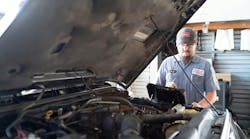PVC is lightweight, inexpensive, and easy to purchase at any local building supply store, making it all the more attractive when it comes to selecting piping materials for a compressed air system.
Using PVC, however, has its risks. And in certain areas, it may not be code compliant. It also carries a static charge which can lead to spontaneous combustion in certain dust filled environments, it’s subject to bursting (yes bursting), and the adhesives used in installation are not compatible with all types of compressor oils. Despite the safety issues, many small shops and even some larger plants continue to use it.
A couple years back we were installing a compressor at a medical device manufacturer in Colorado, and we noted the plant’s wide use of PVC piping. I asked the shop manager (who was three weeks from retiring) whether they’d had any issues with PVC cracking or bursting under pressure. He said yes, many times. “Pieces fly across the room.” He would just replace them. “No one’s been hurt so far…”
In a room with four huge, expensive injection molding machines and many employees, he saw no need to change. Different strokes, I guess.
(See another example in the photo above)
If you have PVC pipe in your shop or factory, make sure it’s pressure rated and regularly check it for signs of cracking.
For those of you considering using PVC pipe, I urge you not to—it’s really not worth the risk.
Information provided by: Kaeser Compressors, Inc. (www.kaesertalksshop.com)


